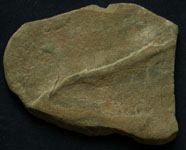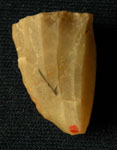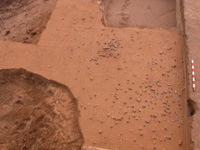
Footprint on the bank of Yelllow River– the Paleolithic Longwangcan site in Yichuan, Shannxi
From:Chinese Archaeology NetWriter:Wang XiaoqingDate:2007-04-10
The origin of microlithic industry and dry-land agriculture in north China has long been a hot topic in Chinese archaeology. The cooperative fieldwork conducted by the Institute of Archaeology, CASS and the Shannxi Provincial Institute of Archaeology at the Longwangcan site in the Hukou Twoship, Yichuan County, Shannxi Province purposes to find new evidence for a better understanding of the transition from Paleolithic to Neolithic in north China.




Scientific excavations and surveys started in 2004 has discovered 21 locations at the terraces beside the Yellow River and unearthed a large number of stone objects and animal bones. Within the more than 40 sq m exposed area at Location I beside Longwangcan which is 483 m above the sea level, were discovered more than 20,000 pieces of stone objects, including microlithic cores, blades, tools, raw stone materials and debris of stone tools manufacture. Microlithic cores are conic, semi-conic, cylinder and wedge shaped. Main microlithc tools include scraper, points and graves. They show some characteristics of the Huabei microlithic industry tradition. There are also some large chipped stone tools, such as point, chopper and hammer. Significantly, millstone and chipped spade with polished blade were unearthed. Besides, more than 20 contexts of fire using were recognized.
The site, probably can be dated to 20,000 to 15,000 BP, will trigger new discussions on the mysterious transition from Paleolithic to Neolithic in north China.





